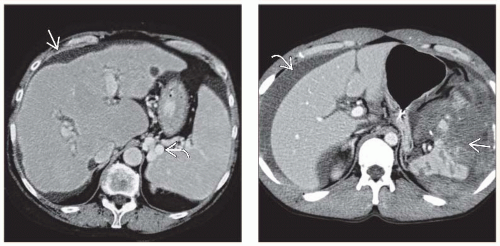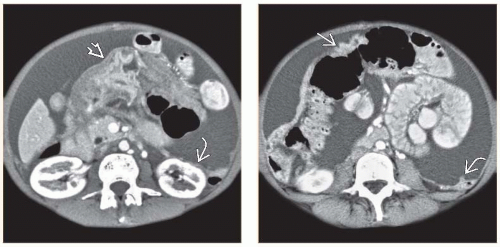Ascites
Michael P. Federle, MD, FACR
Key Facts
Terminology
Pathologic accumulation of fluid within peritoneal cavity
Imaging
Uncomplicated ascites: Homogeneous, freely mobile, anechoic collection; deep acoustic enhancement
In uncomplicated cases, fluid flows to most dependent recesses
Morison pouch (hepatorenal fossa), rectovesical space
Lesser sac usually does not fill with ascites
Exceptions: Tense ascites, local source (gastric ulcer or pancreatitis)
Otherwise, usually due to carcinomatosis or infected ascites
Loculated: Rounded, bulging contour, encapsulated, displaces organs
Implies adhesions, malignancy, or infection of peritoneum
Complicated ascites: Exudates, infection, inflammation, malignancy
Exudates: Density of ascitic fluid increases with increasing protein content
Top Differential Diagnoses
Hemoperitoneum
Malignant ascites
Infectious ascites
Cystic peritoneal metastases
Diagnostic Checklist
Recognize signs of exudative ascites, consider paracentesis for specific diagnosis
High-attenuation ascites can result from vicarious excretion
TERMINOLOGY
Definitions
Pathologic accumulation of fluid within peritoneal cavity
IMAGING
General Features
Best diagnostic clue
Diagnostic paracentesis (to confirm infection or tumor)
Location
In uncomplicated cases, fluid flows to most dependent recesses
Morison pouch (hepatorenal fossa)
Most dependent upper abdominal recess
Pelvis
Rectouterine or rectovesical space: Most dependent space
Paracolic gutters
Subphrenic spaces
Lesser sac
Usually does not fill with ascites
Exceptions: Tense ascites, local source (gastric ulcer or pancreatitis)
Otherwise, usually due to carcinomatosis or infected ascites
Morphology
Free-flowing fluid: Shaped by surrounding structures & does not deform normal shape of adjacent organs
Fluid insinuates itself between organs
Loculated: Rounded, bulging contour, encapsulated, displaces organs
Key concepts and descriptors
Transudate, exudate, hemorrhagic, pus
Chylous, bile, pancreatic, urine, cerebrospinal fluid
Pseudomyxoma peritonei, neonatal ascites
Radiographic Findings
Plain abdominal film: Insensitive for diagnosis
Hellmer sign: Lateral edge of liver medially displaced from adjacent thoracoabdominal wall
Obliteration of hepatic and splenic angle
Symmetric densities on sides of bladder (“dog ears”)
Medial displacement of ascending and descending colon, lateral displacement of properitoneal fat line
Stay updated, free articles. Join our Telegram channel

Full access? Get Clinical Tree













